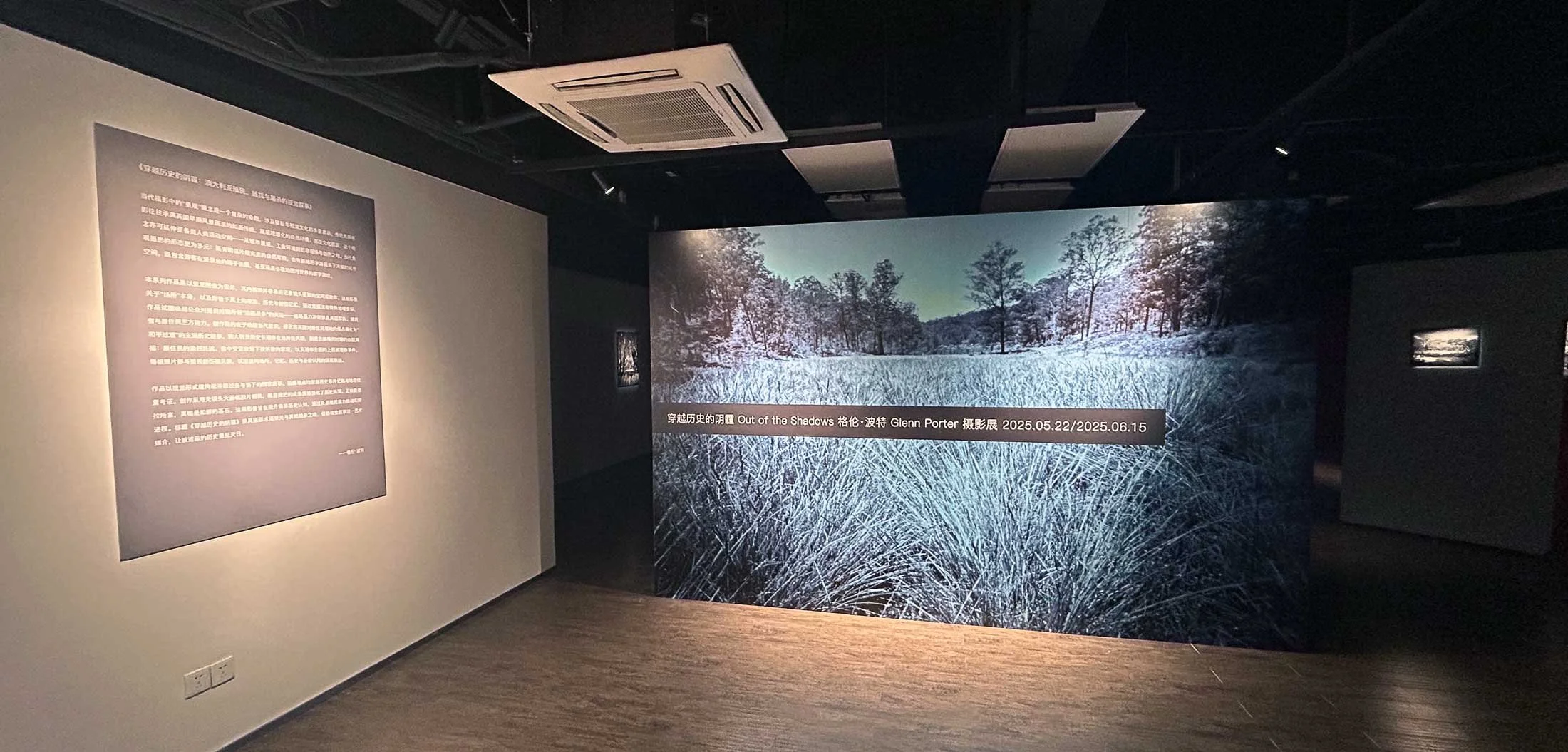Solo Exhibition in China
Out of the Shadows Exhibition
The Out of the Shadows solo exhibition was held at the 5A1 Art Space Gallery in Shenzhen, China, from May to June 2025. The following critique, written by exhibition curator Chun Wai, is available in both English and Chinese versions. My most profound appreciation to David Lai, curator Chung Wai, Helen and the gallery staff for all their hard work in putting this show together.
Trees cannot speak, yet their roots hold the memory of the land.
Australian photographer Glenn Porter’s “Out of the Shadows” series captures the scars of this land, the stories of its people, and the silent weeping of the trees. Porter’s lens focuses on the gorges, cliffs, and wilderness of New South Wales—places that were once home to Indigenous communities living in symbiosis with the land for tens of thousands of years, only to become sites of massacre, displacement, and cultural erasure after British colonisers invaded in the late 18th century.
"Historical records show that the Anaiwan people of the New England region fiercely resisted the colonisers who seized their land. Yet many were driven into the gorges, thrown off cliffs, or gunned down. An oral account from an Anaiwan elder reads: ‘My grandmother was killed at the cliffs near Armidale. They killed so many of our people—threw them off the cliffs, right at Wollomombi… They herded Black folks like kangaroos and shot them.’" Wollomombi Gorge, 2022 – Anaiwan Country
"This ancient eucalyptus stands in the valley where the atrocity occurred. In 1825, six innocent Indigenous family members were murdered here, mistaken for a group pursued by colonial forces. The tree’s girth and rings suggest it may have already stood witness to the massacre. The land holds memory; landmarks like this tree and the surrounding boulders remain as reminders—evidence of history and traces of violence still rooted in this place." Garland Valley Massacre, 2022 – Wonnarua Country
Within the context of contemporary landscape photography, these images do not merely offer an aesthetic gaze upon natural terrain. Instead, they translate "landscape" into "place"—a vessel embedded with historical violence, resistance, and cultural rupture. Here, "place" transcends geographical coordinates, becoming a site where colonial brutality and Indigenous spirituality intertwine—a testimonial long absent from national narratives.
The significance of “Out of the Shadows” lies in its revelation of photography’s archival power and agency. While modern Australia’s national identity has marginalised Indigenous suffering, Porter’s lens brings sites of massacre, missionary detention, and resistance back into public consciousness. These images are not just visual evidence but an act of memory politics—by reshaping our understanding of place, photography forces society to confront historical plurality, redefining "belonging" within the tension of trauma and reconciliation.
Glenn Porter’s work reminds us that landscapes are never neutral. In the contemporary context, places are intersections of layered memory, violence, and spirituality. His images are both an indictment of colonial history and an homage to Indigenous worldviews—the land is silent, but it never forgets. In an era where national narratives still seek to gloss over wounds, perhaps this is photography’s mission: to transform places into unhealed scars, compelling viewers to hear the weeping of trees and the cry of the land.
Chun Wai (Curator)
樹木不會說話,但它們的根系深扎著土地的記憶
澳大利亞攝影師格倫·波特(Glenn Porter)的《穿越陰霾》(Out of the Shadows)系列作品,鏡頭所載是這片土地的傷痕,人類的故事,樹木正為此飲泣低吟。波特的鏡頭聚焦於澳洲新南威爾士地區的峽谷、懸崖與荒野。這些場所曾是原住民數萬年來與土地共生的聚落,卻在18世紀末英國殖民者入侵後,淪為屠殺、驅逐與文化滅絕的現場。
「據記載,新英格蘭地區的阿納伊萬人曾頑強抵抗侵佔他們土地的殖民者。然而,許多人被驅趕至峽谷一帶,或被推下懸崖,或遭槍殺。一位阿納伊萬老婦人的口述記錄如下:「我的祖母在阿米代爾附近的懸崖遇害。他們殺害了我們很多族人 - 把他們推下懸崖,就在沃洛蒙比.⋯⋯他們像圍獵袋鼠一樣把黑人驅趕到一起槍殺。」Wollomombi Gorge, 2022 – Anaiwan Country
「這棵古老的桉樹矗立在慘案發生的山谷中。1825年,六名無辜的原住民家庭成員在此遇害——他們被誤認作殖民小隊搜捕的族群。桉樹的粗壯樹圍與年輪昭示,它或許早在那場屠殺時便已存在,成為沉默的見證者。大地承載記憶,諸如古樹與巨岩等地標,始終提醒著人們:歷史的證據與暴行的痕跡,仍深植於此地。」Garland Valley Massacre, 2022 – Wonnarua Country
在當代景觀攝影的語境中,這些影像所承載的並非僅僅是自然地貌的審美凝視,而是將「景觀」轉譯為「場所」——一個深植歷史暴行、抵抗印記與文化斷裂的空間載體。此處的「場所性」超越了地理座標的物理意義,成為殖民暴力與原住民靈性交織的記憶場域,亦是國家敘事中長期缺席的歷史證言。
《穿越陰霾》的意義,在於它揭示了攝影的檔案性與能動性。當代澳洲的國家認同建構,長期將原住民的苦難邊緣化,而波特的鏡頭則將屠殺現場、教會拘禁地、抗爭戰場等「歷史爆點」重新置入公共視野。這些影像不僅是視覺證據,更是一種記憶政治的行動——通過重塑場所的認知,攝影迫使社會正視歷史的複數性(historical plurality),並在創傷與和解的張力中,重新定義「歸屬」的內涵。
格倫·波特的攝影提醒我們,景觀從非中立。當代語境下的場所,是層疊的記憶、暴力與靈性的交匯點。這些影像既是對殖民史的控訴,亦是對原住民世界觀的致意——土地沉默,卻從未遺忘。在國家敘事仍試圖粉飾傷痕的當下,攝影的使命或許正是如此:將場所轉化為未癒合的傷口,讓觀者在凝視中,聽見樹木的飲泣與土地的吶喊。
策展人 秦偉

